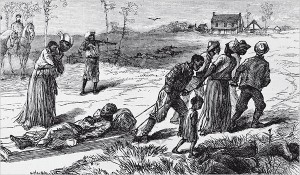On March 13th 1873, a brutal massacre occurred in Colfax, Louisiana that remains shockingly little-known considering the magnitude of the violence – it is one of the largest incidents of race-related mass murder in America’s non-combatant history – and the colossal implications it would trigger. Occurring just eight years after the end of the American Civil War, not only would the Colfax Massacre herald the end of the Reconstruction Era and the so-called “second birth” of the United States, but some modern historians have also pinpointed it as the precise moment that “freedom died”. Henceforth, America would descend into a dark age of segregation so systematic and endemic it would endure for almost 100 years. So what happened on that Easter Sunday in Louisiana? What were the implications? And why don’t we know about it?
Following the war, the Radical Republicans were committed to enfranchising blacks and incorporating them into the political system, while the Democrats and white supremacists were doing all they could to restore the South’s pre-war power and intimidate their former slaves from voting. In 1868, these two irreconcilable agendas clashed head-on in Louisiana when Republican pressure resulted in the election of 137 black state legislators. White supremacists mounted a sustained campaign of terror against the new government; black and white Republicans were threatened, beaten and killed in a desperate bid to drive them away from the polls and out of office. When Louisiana’s gubernatorial election of 1872 ended in dispute as both the Democrat and Republican candidates claimed victory, whites seized the opportunity to destroy once and for all this new black stronghold. As the violence escalated across the state, some 150 black men assembled at the Colfax courthouse in central Louisiana to rally for and defend their civil rights. For several weeks, a group of ex-Confederate soldiers solicited support from surrounding parishes and, at noon on Easter Sunday, a mob of more than 300 white men on horseback, armed with rifles and cannon, descended on Colfax. A shoot-out ensued, and the courthouse was set on fire. The outnumbered black defenders showed a white flag of surrender but were gunned down as they tried to flee the burning building. At least fifty blacks were captured but were later summarily executed. By dawn on Easter Monday, Colfax was littered with the mutilated corpses of over 100 black men.
Although 97 were indicted for the Colfax Massacre, only nine of the ringleaders were eventually charged – not with murder, but with conspiring to deprive their victims of the civil rights guaranteed by the 14th Amendment. The defendants’ lawyers countered that the amendment didn’t empower the federal government to prosecute citizens; that responsibility remained with state governments. Most of the cases ended in botched mistrials, but three of the defendants were found guilty. The appeal went all the way to the U.S. Supreme Court in the landmark case of the United States v. Cruikshank. And, on 27th March 1876, the Supreme Court ruled that the Enforcement Act of 1870 based on the Bill of Rights and 14th Amendment applied only to actions committed by the state, and not to those committed by individuals or private conspiracies. In other words, the Colfax prosecution was unconstitutional, and white supremacists were free to wage war against blacks with absolute impunity. The Cruikshank case effectively enabled political parties’ use of paramilitary forces, the way was opened up for all manner of discriminatory laws against blacks, and Reconstruction was abandoned.
The Colfax Massacre remains a buried episode in American history. In Colfax itself, the events of 13th April 1873 are remembered not as a massacre, but as a “riot”. There is a memorial obelisk, but not in honour of the 100-plus murdered blacks – rather, its inscription is “in loving remembrance” of the three “Heroes… Who fell in the Colfax Riot fighting for White Supremacy”. As the author Nate Blakeslee observed, it was there in Colfax and in the unkept promise of Reconstruction that “the battle lines were drawn not just over civil rights for African Americans, but over what kind of nation [America] would become.”



14 Responses to 13th April 1873 – the Colfax Massacre